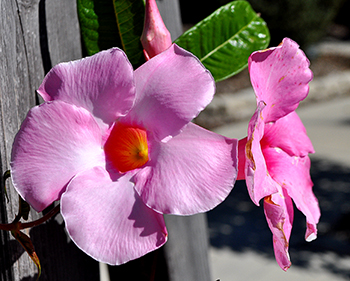Bring Tropical and House Plants in Before Fall
Return to Houseplant Agent Articles
 Oftentimes we move our houseplants outdoors during the summer. The warm summer temperatures and intense sunlight result in strong, vigorous growth for the plants. Or, we simply couldn’t resist that gorgeous tropical at the local nursery so we brought it home and potted it up for the patio. Now that fall has arrived it is time to bring them indoors for winter.
Oftentimes we move our houseplants outdoors during the summer. The warm summer temperatures and intense sunlight result in strong, vigorous growth for the plants. Or, we simply couldn’t resist that gorgeous tropical at the local nursery so we brought it home and potted it up for the patio. Now that fall has arrived it is time to bring them indoors for winter.
Tropical plants and night time temps
Tropical plants thrive best when both daytime and nighttime temperatures are above 65 degrees. Local nighttime temperatures in the mid to low 60’s are cold to a tropical. Cold injury on tropical plants results in the yellowing of foliage. Most of the plants we know as “houseplants” are tropical. Other tropicals typically grown outside in containers here in Kansas City include mandevilla, begonia, coleus and bougainvillea.
How to prep houseplants before bringing them indoors
When moving container plants indoors use some caution as a number of small creatures can be attached to the pot. Start by washing or wiping off the pot. Spiders, slugs, roly-poly’s and even hidden grasshopper eggs can be lurking.
The next step is to clean up the plant. Remove old unproductive leaves. Use a somewhat forceful stream of water to wash the dust from the leaves. Or, instead of water, use a soft cloth to remove the summer layer of dust. Be sure to wash the upper and lower surfaces of the leaves to remove insects, in addition to the dust. Insects hiding in the soil can be evicted by submerging the pot into a tub of water for about 15 minutes. This help flush out bugs living in the soil.
Stop fertilizing
Fall also signals it’s time to stop fertilizing. Lower light levels slow growth. Fertilizer will not result in more growth during the fall and winter. In fact, it could harm the plant by resulting in an increased growth rate that uses up the stored food the plant made over the summer. The result is spindly growth and yellowing of leaves.
How houseplants respond to low indoor light
Winter sunlight in a home is very low compared to summer light outdoors. No matter how much care you give the plant it is not uncommon to see lower or older leaves yellow over the winter. Yellowing is normally a sign of the plant using more food and energy than it can manufacture. Remember, adding more fertilizer during a stressful time can cause more harm than good!
So, don’t get caught off guard with your plants basking in the autumn sun. Now is the time to bring them in for a long winter stay.
by Dennis Patton, horticulture turf and ornamentals agent
Have questions? The Garden Hotline is staffed by trained EMG volunteers and Extension staff who will assist you with questions.
Phone: (913) 715-7050
Email: garden.help@jocogov.org